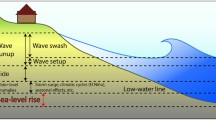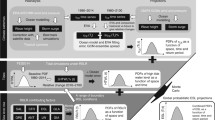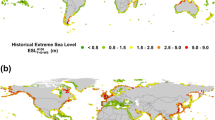Abstract
Estimation of the probability distribution of extreme sea levels, for the present time and the next century, is discussed. Two approaches are described and their strengths and weaknesses are compared. The first approach is based on dynamics and uses a storm surge model forced by tides, winds and air pressure fields. The second approach is based on the statistical analysis of observed hourly sea level records using a new first-order Markov process that can capture non-Gaussian characteristics (such as skewness) in the non-tidal component of the observed sea level record. It is shown that both approaches can provide good estimates of present day flooding probabilities for regions with relatively strong tides. The limitations of both approaches in terms of assessing the effect of global sea level rise, glacial-isostatic adjustment of the land, and changes in the frequency and severity of storms and hurricanes, are illustrated using recent results for the Northwest Atlantic. Some sensitivity studies are carried out to transform uncertainty in climate change projections into uncertainties in the probability of coastal flooding.








Similar content being viewed by others
References
Azzalini A, Capitanio A (2003) Distributions generated by perturbation of symmetry with emphasis on a multivariate skew-t distribution. J R Stat Soc Series B 65:367–389
Bernier NB (2005) Annual and seasonal extreme sea levels in the Northwest Atlantic: hindcasts over the last 40 years and projections for the next century. PhD thesis, Dalhousie University
Bernier NB, Thompson KR (2006) Predicting the frequency of storm surges and extreme sea levels in the Northwest Atlantic. J Geophys Res 111:10009. doi:10.1029/2005JC003168
Bindoff NL, Willebrand J, Artale V, Cazenave A, Gregory J, Gulev S, Hanawa K, Le Quere C, Levitus S, Nojiri Y, Shum CK, Talley LD, Unnikrishnan A (2007) Observations: oceanic climate change and sea level. In: Climate change: the physical science basis. Contribution of working group 1 to the fourth assessment report of the intergovernmental panel on climate change, Cambridge University Press, Cambridge, United Kingdom and New York, NY, USA
Bobanovic J (1997) Barotropic circulation variability on Canadian Atlantic shelves. PhD thesis, Dalhousie University
Coles S (2001) An introduction to statistical modeling of extreme values. Springer Series in Statistics, New York
Flather RA, Smith JA, Richards JD, Bell C, Blackman DL (1998) Direct estimates of extreme storm surge elevations from a 40-year numerical model simulation and from observations. Glob Atmosphere Ocean Syst 6:165–176
Genton MG, Thompson KR (2004) Skew-elliptical time series with application to flooding risk. Time series analysis and applications to geophysical systems. In: Brillinger DR, Robinson EA, Schoenberg FP (eds) IMA volume in mathematics and its applications, no. 139. Springer, New York, pp 169–186
Leadbetter M, Lindgren G, Rootzen H (1983) Extremes and related properties of random sequences and processes. Springer-Verlag, New York
Peltier WR (2004) Global glacial isostasy and the surface of the ice-age earth: the ice-5G(VM2) model and GRACE. Annu Rev Earth Planet Sci 32:111–149. doi:10.1146/annurev.earth.32.082503.144359
Pugh DT, Vassie JM (1980) Application of the joint probability method for extreme sea level computations. Proc Inst Civ Eng Part 2 69:959–975
Swail VR, Ceccafi EA, Cox AT (2000) The AES40 North Atlantic wave reanalysis: validation and climate assessment. In: 6th international workshop on wave hindcasting and forecasting, Monterey, California, USA
Tawn JA, Vassie JM (1989) Extreme sea levels: the joint probability method revisited and revised. Proc Inst Civ Eng (Part 2) 87:429–442. doi:10.1680/iicep.1989.2975
Thompson KR, Shen Y (2004) Coastal flooding and the bivariate skew-t. Chapter 5 of skew-elliptical distributions and their applications: a trip beyond normality. CRC Press, Chapman and Hall
Acknowledgements
Thanks to Val Swail and the conference organizers for the invitation and support to attend the JCOMM surge meeting. Val Swail also provided the winds used in the 40-year surge hindcast. Thanks are also due to Richard Smith for providing insightful comments on Markov Chains, extremal indices and extremal analysis. KRT acknowledges financial support from the Natural Sciences and Environmental Research Council of Canada.
Author information
Authors and Affiliations
Corresponding author
Rights and permissions
About this article
Cite this article
Thompson, K.R., Bernier, N.B. & Chan, P. Extreme sea levels, coastal flooding and climate change with a focus on Atlantic Canada. Nat Hazards 51, 139–150 (2009). https://doi.org/10.1007/s11069-009-9380-5
Received:
Accepted:
Published:
Issue Date:
DOI: https://doi.org/10.1007/s11069-009-9380-5




